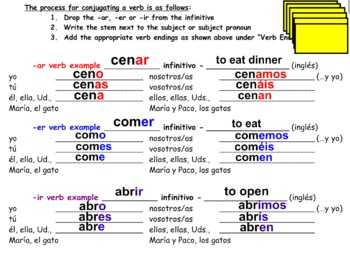In Spanish The Infinitive Is Expressed By The Verb Endings | When you want to change that verb according to a particular tense, you just delete to and alter the verb. The infinitive in english is expressed by writing the word to before a verb. In english, the infinitive is usually thought of as being made up of two words, for example, to speak. It is a non finite or in finite hence infinitive verb form like participles and gerunds which means. Below, we're going to list four common ways to express the above emotions or feelings.
Spanish verbs are grouped in three categories or conjugations. For example, to eat is the infinitive verb that is conjugated to agree with the person who eats, i.e. In english, this is made up of two words, to + verb (e.g. According to the spanish conjugation rules, different forms of the verb are created by removing the infinitive ending, such as ‒ar, ‒er, or ‒ir, and replacing it with the required ending that specifies who is performing an action depending on the used tense and mood (indicative, subjunctive or imperative). Also what are infinitives in spanish.

So, the english equivalent is when you express verbs with 'to' in front, such as 'to write,' 'to read,' and 'to talk. Spanish infinitives are divided into three groups or conjugations: The first step to conjugating spanish verbs is learning to categorize them. The infinitive in english is expressed by writing the word _____ before a verb. In their basic or infinitive form, all spanish verbs can have one of three endings: Two ways to express the spanish future tense. Every spanish verb infinitive has one of these three endings, and their conjugation varies according to their ending—as long as they are regular verbs. In addition, the negation will. However, in spanish, we also use the verb tener (to have) to express certain. The infinitive form means the verb is not conjugated. In addition, the reflexive pronoun used must agree with the subject to which it refers. So, in spanish the infinitive vivir is expressed in english as to live … comer in spanish is to eat in english … caminar in spanish is to walk in english. The same rule of syntax applies to spanish.
Spanish verbs are grouped in three categories or conjugations. There are two ways to form the future spanish tense conjugation. For example, the verb querer, which means to want. Many spanish speakers rarely use personal pronouns, although this varies from country to country. In english, infinitive verbs are preceded by the word to, as in to speak, to read, or to write.

For example, to eat is the infinitive verb that is conjugated to agree with the person who eats, i.e. Cantar → cant ando sing → singing Also what are infinitives in spanish. The first step to conjugating spanish verbs is learning to categorize them. In spanish the infinitive is expressed by the verb endings _____, _____ and _____. Spanish verbs are based in the infinitive. First, we are going to look at the simple future and how conjugation works. So, in spanish the infinitive vivir is expressed in english as to live … comer in spanish is to eat in english … caminar in spanish is to walk in english. There are two ways to form the future spanish tense conjugation. Spanish is a relatively synthetic language with a moderate to high degree of inflection, which shows up mostly in spanish conjugation. What is infinitive verb in spanish. Below, we're going to list four common ways to express the above emotions or feelings. In english, infinitive is usually used to refer to the to + verb form of the verb such as to run or to eat, although according to some authorities the infinitives are run and eat.
In spanish, the infinitive is expressed by the verb endings ___, ____, and ____ the infinitive in english is expressed by writing the word to before a verb. When you want to change that verb according to a particular tense, you just delete to and alter the verb. Below, we're going to list four common ways to express the above emotions or feelings. The spanish infinitive is a single word with one of the following endings. Many spanish speakers rarely use personal pronouns, although this varies from country to country.

An example of this would be to play, to dance, to sleep, etc. In english, this is made up of two words, to + verb (e.g. Spanish verbs are grouped in three categories or conjugations. The following chart shows the verb endings that are added to the stem of the verb after removing the infinitive ending. Below, we're going to list four common ways to express the above emotions or feelings. The infinitive form (el infinitivo) in english always includes the word to with the verb. So, in spanish the infinitive vivir is expressed in english as to live … comer in spanish is to eat in english … caminar in spanish is to walk in english. These three groupings aren't arbitrary—they signal how the verb should be conjugated. First, we are going to look at the simple future and how conjugation works. The first step to conjugating spanish verbs is learning to categorize them. Spanish is a relatively synthetic language with a moderate to high degree of inflection, which shows up mostly in spanish conjugation. The infinitive is the full form of dictionary form of the verb. The infinitive form means the verb is not conjugated.
In Spanish The Infinitive Is Expressed By The Verb Endings: Because the endings of spanish verbs indicate who the subject of an action is, you can often drop the subject pronoun (yo, tú, nosotros, etc.).
comment 0 Post a Comment
more_vert